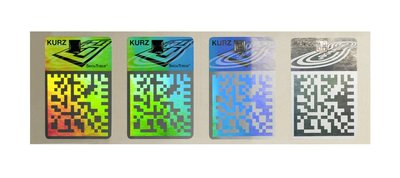Turn 2D barcodes into design elements
Whether on labels or packaging or in magazines or on billboards, 2D barcodes are ubiquitous. But they don’t always make a stylish impression.
Usually they are noticed because they significantly disrupt the overall image. In most cases, they have not been integrated into the design concept and therefore give the impression of an out-of-place foreign object within the design.
But it need not be that way. At Drupa, the international fair for printing, prepress, premedia book binding, print finishing and paper converting, Leonhard Kurz demonstrated how the stamping foil manufacturer has developed diffractive 2D barcodes with an appealing aesthetic that enhances the value of the product. Rather than being printed, the barcode is applied as a silver-coloured stamping foil into which the actual code has been incorporated as a diffractive, holographic-like structure.

The barcode square can be integrated into a larger metallised design with further holographic details. The code could, for example, be combined with difficult-to-counterfeit optical security features. It would also be possible to integrate corporate design elements into the metallised area in order to harmoniously blend the integrated code into the brand image. Alternatively, the diffractive 2D code can be applied as a standalone single image which the consumer will immediately recognise as an authenticity feature, thereby reinforcing the brand value.
While Kurz’s diffractive 2D codes cannot be compared with printed codes in terms of their appearance, they are comparable in terms of functionality. They can also be read both with a scanner or smartphone and offer the same fast, ready access to mobile information.
Kurz has installed an internet-based identification system called Secutrace that can deliver a wide range of product data for end consumers, dealers, customs officials or manufacturers of branded goods. This data can be accessed in real time via the 2D code. A purchaser, for example, could confirm the authenticity of a brand name product via their mobile phone. The 2D code could also be used to access product information, loyalty programs or interactive games.
Secutrace gives brand-name manufacturers the ability to access micromarketing data and thereby accurately identify their target audiences and provide them with tailored offers. They can also trace the movement of the product through the entire supply chain. All code-specific queries are logged, analysed and evaluated by the identification system. Brand-name manufacturers can access these reports at any time to give them greater insights into the movement of the product and to enable them, for example, to more easily discover parallel sales.
Apricot packaging goes linerless
Blossom Hill Packing has introduced a linerless fruit lid/fibre-based tray combo as part of its...
Edenvale Foods focuses on product innovation with the help of automation
As the functional snackfood business enters its next phase, it became crucial to upscale to...
Intelligent packaging solutions for the bakery industry
There have been many advancements in the bakery industry in recent years, particularly in the...








